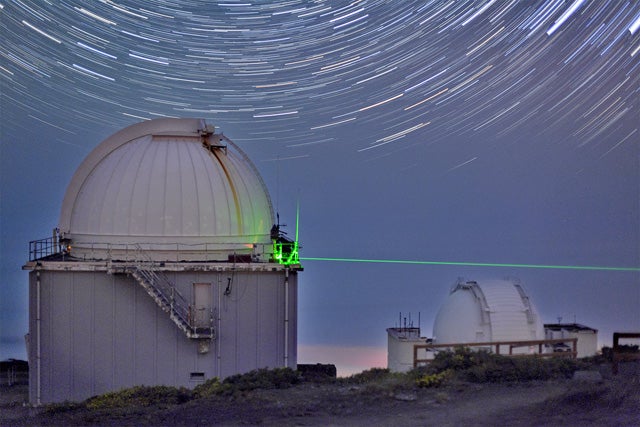Wednesday, September 5, 2012
Three IQC scientists were part of an international research team that achieved a record-breaking quantum teleportation across the Canary Islands.

An international research team including several IQC scientists has achieved quantum teleportation over a record-breaking distance of 143 kilometres through free space.
The experiment saw the successful teleportation of quantum information (in this case, the states of light particles, or photons) between the Canary Islands of La Palma and Tenerife. The breakthrough is a crucial step toward quantum communications via satellite.
Unlike the teleportation of solid objects popularized in science fiction, the experiment involved the teleportation of quantum states — an essential pre-requisite of quantum computing, quantum communication and other powerful technologies under development at uWaterloo.
The project, led by researchers from Vienna’s Institute for Quantum Optics and Quantum Information, relied on algorithms and equipment developed in Waterloo. Their results were published this week in Nature.
Teleportation across 143 kilometres is a crucial milestone in this research, since that is roughly the minimum distance between the ground and orbiting satellites. This leads to the possibility of quantum teleportation between ground stations and orbiting satellites — a key goal in the research of IQC faculty member Thomas Jennewein, a collaborator on the record-setting experiment.
For this experiment, Jennewein developed the “coincidence algorithm” that synchronized and measured the transfer of photons between the two sites in the Canary Islands.
The ultra-precise “clocks” needed to measure the teleportation of photon states were aligned to each other to within a nanosecond (one billionth of a second). Such precision will be necessary in the development of satellite-based quantum communications networks.
“The experiment paves the way toward teleportation of signals over free space, or even using satellites,” said Jennewein, whose research is largely focused on the creation of large-scale quantum communications networks. “This is useful for applications in secure communication, as well as the possibility of networking full-scale quantum computers, once they exist.”
Jennwein added that the successful experiment was “a huge effort in terms of resources, expertise and planning, which was really impressive.”
IQC research assistant professor Vadim Makarov, along with PhD student Elena Anisimova, designed the highly sensitive photon detectors, which allowed the teleportation to occur in high fidelity despite some hazy air conditions.
Makarov and Anisimova were recruited to help overcome inclement atmospheric conditions caused by dust whipped up from the Sahara Desert in the summer 2011, which foiled the first attempt at the teleportation experiment. Makarov’s photon detectors, and more cooperative weather, allowed for a successful experiment last April.
Because there is less atmospheric disturbance when communicating upwards to space than between the Canary Islands, Makarov says the “next logical step” is to attempt teleportation between the earth and a satellite.
Makarov was in the Canary Islands for the experiment, but Jennewein stayed in Waterloo, connecting with his international colleagues via Skype to lend troubleshooting tips and scientific expertise.
Although beaming himself to the Canary Islands would have been nice, the true science does not yet allow the kind of “beam me up” teleportation popularized in science fiction.